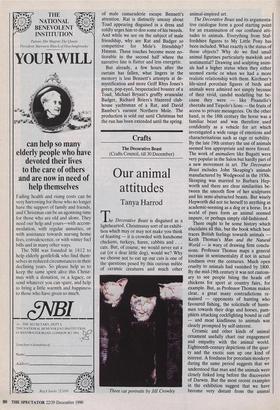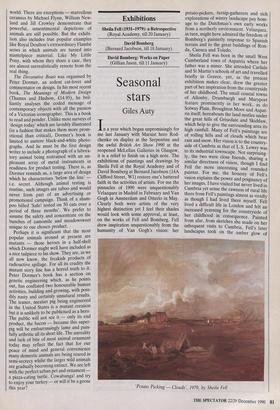Crafts
The Decorative Beast (Crafts Council, till 30 December)
Our animal attitudes
Tanya Harrod
The Decorative Beast is disguised as a lighthearted, Christmassy sort of an exhibi- tion which may or may not make you think of feasting — it is crowded with handsome chickens, turkeys, hares, rabbits and . . . cats. But, of course, we would never eat a cat (or a dear little dog), would we? Why we choose not to eat up our cats is one of the questions posed by this curious mêlée of ceramic creatures and much other Three cat portraits by Jill Crowley animal-inspired art.
The Decorative Beast and its argumenta- tive catalogue form a good starting point for an examination of our confused atti- tudes to animals. Everything from Staf- fordshire figures to My Little Pony has been included. What exactly is the status of these objects? Why do we find small animal figurines particularly mawkish and sentimental? Drawing and sculpting anim- als had a higher status when they either seemed exotic or when we had a more realistic relationship with them. Kirchner's life-sized porcelain figures of birds and animals were admired not simply because of their vivid, candid modelling but be- cause they were — like Pisanello's cheetahs and Tiepolo's lions — the fruits of access to private menageries. On the other hand, in the 18th century the horse was a familiar beast and was therefore used confidently as a vehicle for art which investigated a wide range of emotions and characterisations such as rage or nobility. By the late 19th century the use of animals seemed less appropriate and more forced. The work of animaliers like Bugatti were very popular in the Salon but hardly part of a new movement in art. The Decorative Beast includes John Skeaping's animals manufactured by Wedgwood in the 1930s. Skeaping was married to Barbara Hep- worth and there are clear similarities be- tween the smooth flow of her sculptures and his semi-abstracted beasts. But wisely Hepworth did not tie herself to anything as academic-seeming as a dog or a horse. In a world of pure form an animal seemed impure, or perhaps simply old-fashioned.
There ought to be some history which elucidates all this, but the book which best traces British feelings towards animals Keith Thomas's Man and the Natural World — is wary of drawing firm conclu- sions. Professor Thomas maps a general increase in sentimentality if not in actual kindness over the centuries. Much open cruelty to animals had vanished by 1800. By the mid-19th century it was not custom- ary to see people biting the heads off chickens for sport at country fairs, for example. But, as Professor Thomas makes clear, a great many contradictions re- mained — opponents of hunting who favoured fishing, the solicitude of hunts- men towards their dogs and horses, pam- phlets attacking cockfighting bound in calf — and most kindliness to animals was clearly prompted by self-interest.
Ceramic and other kinds of animal ornament usefully chart our engagement and empathy with the animal world. Eighteenth-century depictions of the quar- ry and the exotic sum up one kind of interest. A fondness for porcelain monkeys during the same period suggests that we understood that man and the animals were closely linked long before the discoveries of Darwin. But the most recent examples in the exhibition suggest that we have become very distant from the animal world. There are exceptions — marvellous ceramics by Michael Flynn, William New- land and Jill Crowley demonstrate that powerful, unsentimental depictions of animals are still possible. But the exhibi- tion also includes true popular examples like Royal Doulton's extraordinary Flambe series in which animals are turned into mantelpiece material. Like My Little Pony, with whom they share a case, they are almost surrealistically remote from the real thing.
The Decorative Beast was organised by Peter Dormer, an ardent cat-lover and commentator on design. In his most recent book, The Meanings of Modern Design (Thames and Hudson, £14.95), he bril- liantly analyses the coded message of contemporary objects with all the passion of a Victorian iconographer. This is a book to read and ponder. Unlike most surveys of `design today' which are lavishly illustrated (in a fashion that makes them more prom- otional than critical), Dormer's book is limited to austere black-and-white photo- graphs. And he must be the first design writer to include a photograph of a labora- tory animal being restrained with an un- pleasant array of metal instruments in readiness for product testing. There is, as Dormer reminds us, a large area of design which he characterises 'below the line' i.e. secret. Although animal testing is routine, such images are taboo and would never form part of an advertising or promotional campaign. Think of a sham- poo billed 'Safe! tested on 50 cats over a period of three months'. We prefer to assume the safety and concentrate on the bunches of camomile and meadowsweet unique to our chosen product.
Perhaps it is significant that the most popular animals around at present are mutants — those heroes in a half-shell which Dormer might well have included as a nice tailpiece to his show. They are, as we all now know, the freakish products of radioactive spillage. For all its crudity the mutant story line has a horrid truth to it. Peter Dormer's book has a section on genetic engineering which, as he points out, has conflated two honourable human activities, building and growing, with poss- ibly nasty and certainly unnatural results. The leaner, meatier pig being engineered in the United States is a mutant creation but it is unlikely to be publicised as a hero. The public will not see it — only its end product, the bacon — because this super- pig will be embarrassingly lame and pain- fully arthritic all its short life. The unreality and lack of bite of most animal ornament today may reflect the fact that for our peace of mind and general convenience many domestic animals are being reared in semi-secrecy whilst the larger wild animals are gradually becoming extinct. We are left with the perfect urban pet and ornament — a pizza-eating turtle. Cowabunga! and try to enjoy your turkey — or will it be a goose this year?



































































































 Previous page
Previous page